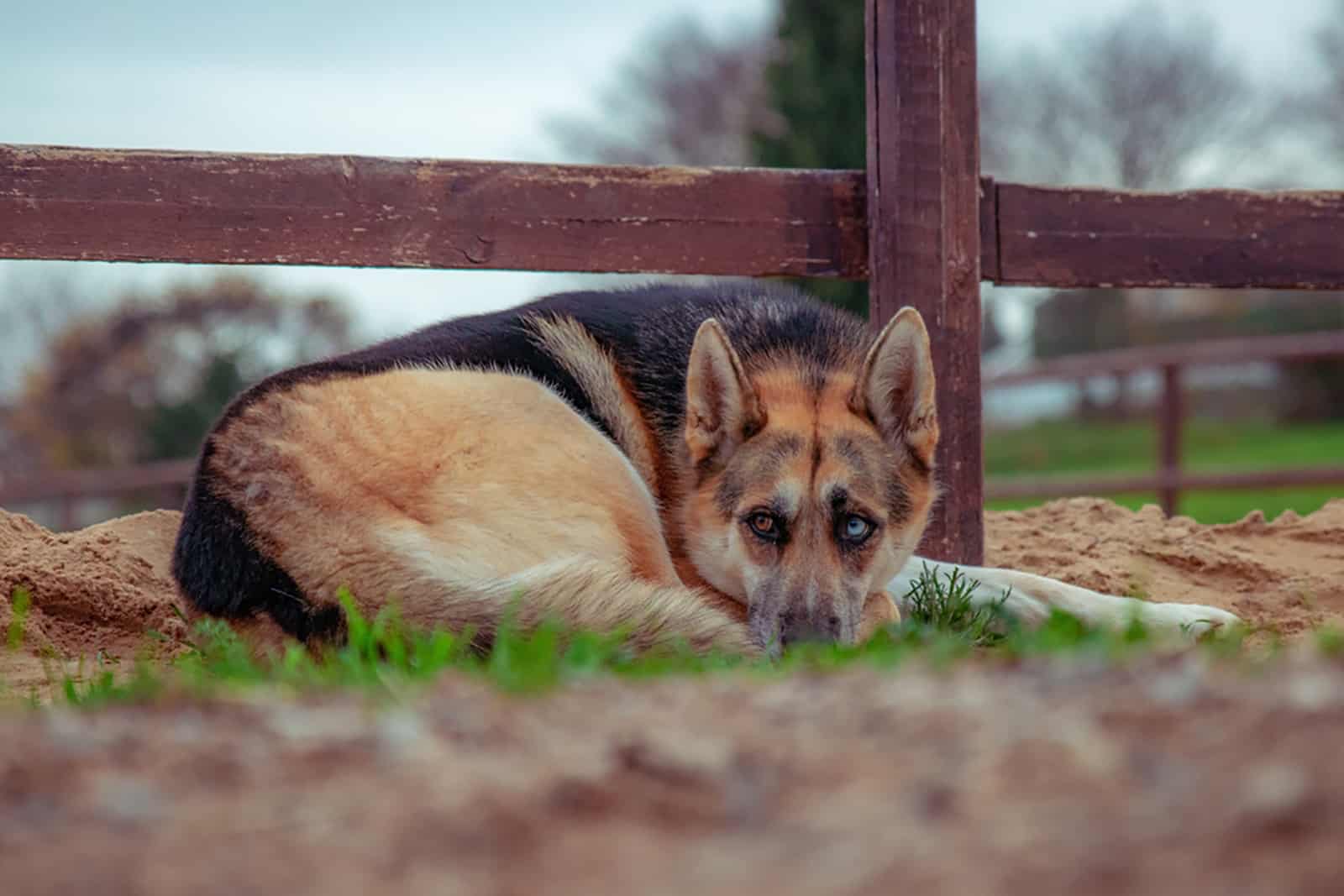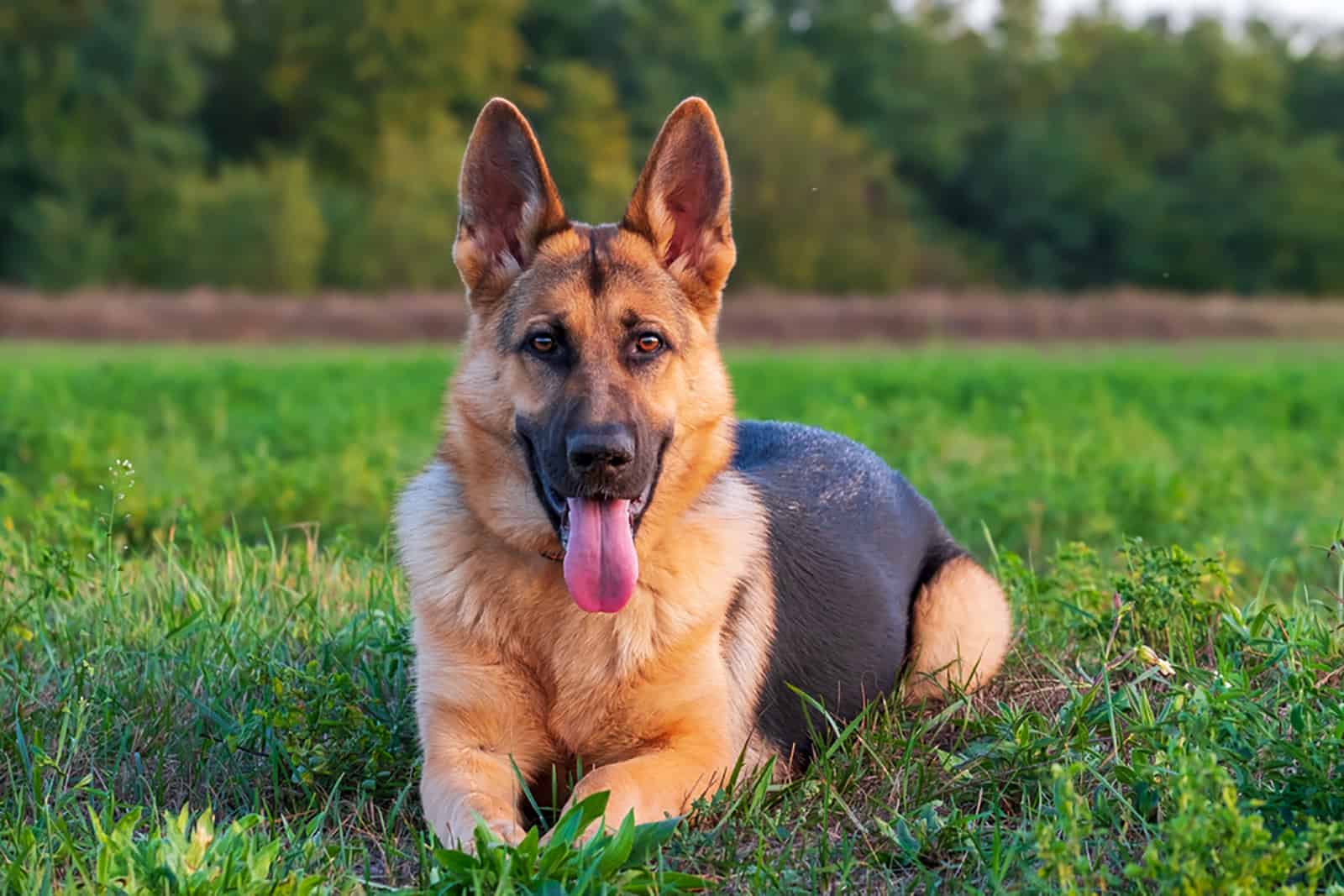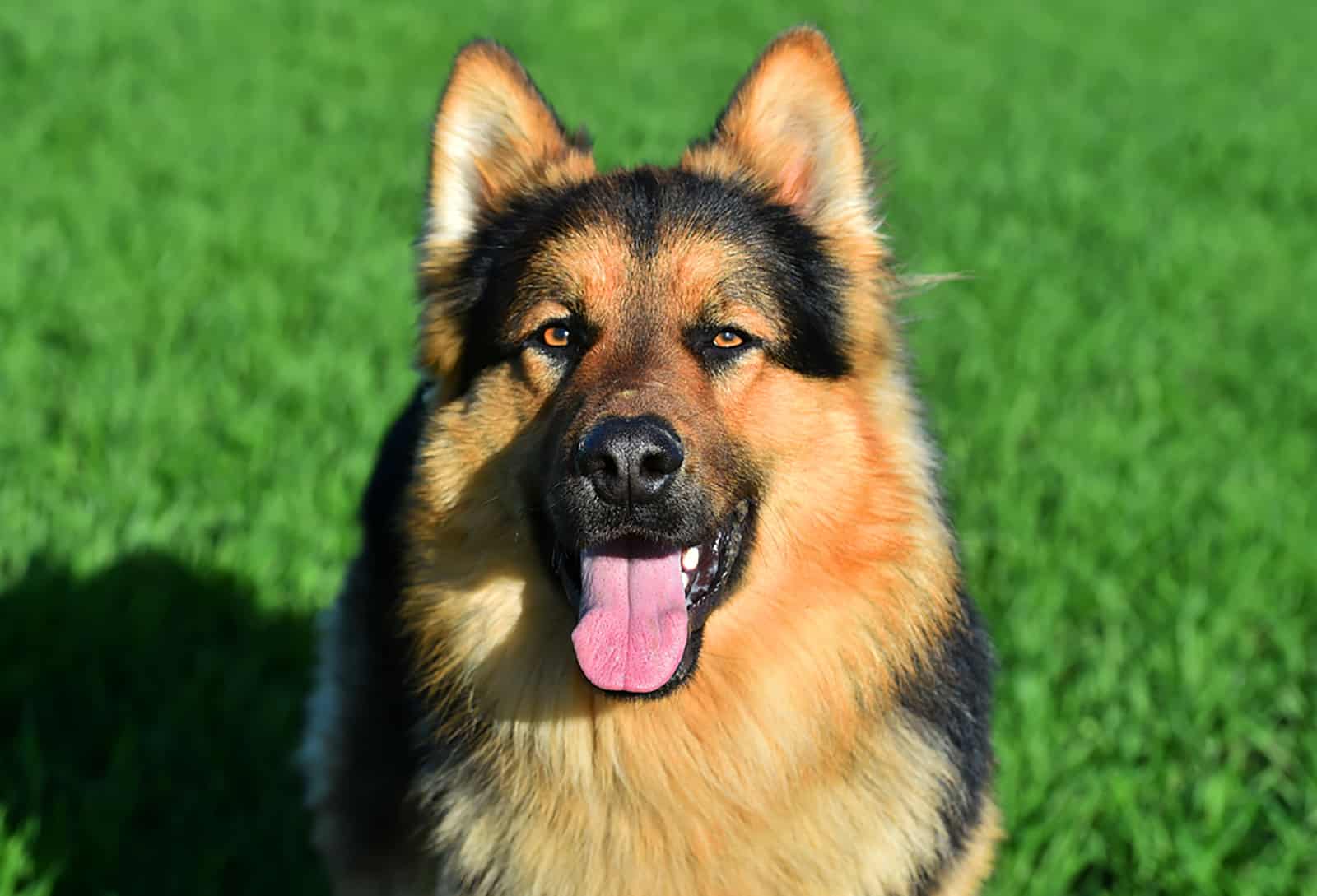German Shepherd dogs (GSD) are one of the most popular and easily recognizable dog breeds in the world.
Considered by many to be one of the best dog breeds, they are the ultimate companions, characterized by their strength, courage, intelligence, and loyalty.
Although a lot is known about these noble dogs, there are still some details that people are unfamiliar with. One example is the varying German Shepherd eye colors.
When you think of a German Shepherd, you probably imagine them with brown eyes, but that’s not always the case.
True, brown is the most represented color, but it comes in a variety of different shades and nuances that you can easily notice if you take a closer look.
Beyond brown, there are other color variations that make dogs stand out from the rest and be noticed.
In this article, we will be covering all the different eye colors a GSD can have, the genetic and evolutionary influence behind them, as well as any possible associated health conditions.
Different Eye Colors In German Shepherds

There are many subtle nuances in a GSD’s eye color, and it can even change with time.
However, if we observe it from a larger scale, looking at the breed as a whole, we can roughly divide German Shepherds’ eye color into standard and non-standard colors.
Standard Eye Colors In German Shepherds
As you might have assumed, this group of eye colors includes all the most common variations. These are the colors that have been the most well represented throughout the evolution of the breed.
Use of the word “brown” can sometimes be described as an umbrella term, but if we dig a bit deeper, there are several distinct shades. Some of the most frequent ones are yellow, amber, hazel, light brown, medium brown, and dark brown.
Sometimes the brown can get so dark that it looks almost black in some dogs, especially in poor lighting conditions.
Dark brown eyes are technically considered desirable. In fact, the American Kennel Club describes German Shepherd eyes to be as dark as possible in their official breed standard guidelines.
What Is Melanin?
The main reason for the prevalence of brownish eye colors in German Shepherds is a substance called melanin.
Melanin is a broad term for a group of amino acids present in humans and animals, and it’s responsible for pigmentation of the hair (or coat), eyes, and skin.
The more melanin the body produces, the darker the pigment will be.
Non-Standard Eye Colors In German Shepherds
Apart from the much more widely represented shades of brown and yellow, German Shepherds can sometimes have quite unusual eye colors.
Some of the most beautiful and exotic examples are light blue, dark blue, violet, or even a liver-colored variant. You are most likely to see these shades in a German Shepherd puppy, but they occasionally show up in adult dogs as well.
Contrary to some beliefs, there is no causal relationship between non-standard eye colors (such as blue) and any health issues.
There have been claims that the gene that causes blue eyes is linked with deafness in some dogs, but this has never been officially proven.
There are also cases of them having green eyes, but that is probably the rarest instance, and it usually only appears in mixed breed dogs.
What Is Heterochromia?

Heterochromia is one of the most interesting phenomena when it comes to eyes in general. In essence, it’s a condition where each eye is a different color.
This can appear in many animals, including dogs, but it can also happen to humans. There has been a lot of speculation throughout history that this might be a sign of illness or poor vision, but it has been disproven by veterinary science.
Heterochromia is not harmful to the eye in any way, it just makes them look different from each other. However, this is only true if the dog was born with it. If one of the eyes changes color during the pup’s life, then it would be wise to consult an expert.
Why Does It Happen?
It occurs as a result of noticeable differences in the pigmentation of each eye and, in the case of dogs, one of the eyes is usually blue.
It is often considered hereditary, which means that dogs with multi-colored eyes are more likely to produce offspring with the same condition.
German Shepherds get it occasionally, but it is most commonly associated with breeds such as Australian Shepherds, Siberian Huskies, Dalmatians, Border Collies, and Great Danes.
There are three distinct versions of heterochromia: central heterochromia, sectoral heterochromia, and heterochromia iridis.
Central Heterochromia
This particular variation means that the lack of pigment starts in the pupil — i.e. the center of the eye, hence the name — and spreads out evenly around the iris. It happens simultaneously in both eyes, making both of them bi-colored.
Central heterochromia is extremely rare.
Sectoral Heterochromia
This type, often called partial heterochromia, causes only a part or a sector of the dog’s eye to be without pigment. So the iris is partially blue, and the rest of the eye is a regular color.
Multi-colored eyes like these are mostly found in dogs with the Merle gene, but they can also occur in regular German Shepherds.
Heterochromia Iridis
The iridis variant is in fact the so-called complete heterochromia. This is perhaps the most eye-catching case (no pun intended) of the three, because dogs with this condition have one eye fully blue and the other one completely brown.
This is the result of a complete lack of melanin in one eye.
Are German Shepherds With Different Eye Colors Purebred?
The gene that causes some German Shepherd puppies to be born with, for example, blue eyes is naturally occurring. Therefore, blue-eyed GSDs are considered natural.
However, the question of whether they are a purebred dog or not is slightly more complicated and debated.
The blue eyes feature, while charming and even desirable in some cases, is technically considered to be an anomaly that doesn’t align with the breed standards.
That’s why kennel clubs, including the AKC, don’t list breeders who produce blue-eyed Shepherds. This further results in breeders trending away from producing such dogs, which is making them become even more rare.
What Is the Most Desirable Eye Color In German Shepherds?

There are multiple ways to look at this question, and there is hardly a definitive answer.
One side of the story is that the AKC considers blue eyes to be a fault in German Shepherds and, therefore, does not accept such dogs as part of the breed standard.
Likewise, when it comes to dog shows, only dogs with standard color eyes are allowed to be entered.
However, since German Shepherd eye color does not affect them in any other physical way, they would still be able to partake in any agility or athletics competition without being hampered.
On the flip side, there are people who specifically seek out blue-eyed German Shepherds, purely because they like the way they look.
The combination of piercing blue eye color and dark coat color can be quite an aesthetically pleasing one, so it’s no surprise.
When it comes down to it, eye color is a matter of personal preference of the owner in most cases.
Are German Shepherds With Blue Eyes Special?

Photo from: @blueshepherd.storm
As noted in the paragraph just above, no particular German Shepherd eye color is special in and of itself. That being said, there are a couple of interesting facts associated with German Shepherds that have blue eyes.
Blue eyes in German Shepherds are carried by a recessive gene, so the possibility of puppies inheriting this trait from their parents is very slim, thus the brown eyed version is much more common.
An important distinction is the existence of White German Shepherds with blue eyes. Unlike Black German Shepherds who are classed under the same breed, the white ones are considered a separate breed and they have a very different set of genetic material. They have much higher chances of having blue eyes.
Another quirky trait is that the chances of a German Shepherd having blue eyes are much higher if their coat is liver-colored. Additionally, there are also blue-eyed GSDs with a sable coat, although not as many.
Anything rare is often considered special so, by that logic, we could say that blue-eyed GSDs are as well. However, we like to think that all dogs are special and that we should love them all the same.
German Shepherd Eye Colors Through History

German Shepherds were first bred in Germany in the late 19th century, and we have a man called Max von Stephanitz to thank for creating this gorgeous breed.
Unfortunately, there are no official records from the time that describe their particular eye color, but there are ways we can figure it out from context.
All early shepherd dog breeds originated from mixing wolves with domestic dogs.
And since both wolves and those early dogs have eyes on the scale from yellow to brown, it’s safe to assume that the German Shepherd probably had a similar shade when it was first introduced.
But as we know now, that didn’t remain the case for long.
Can German Shepherd Eye Color Change With Time?

Just like with all dogs, the color of German Shepherds’ eyes changes from puppyhood to adulthood — in most cases.
However, once they fully develop and mature, their eyes should stay the same and any change in color could indicate that there are medical issues developing.
But let’s dig a bit deeper into this, and talk separately about the eye color in puppies vs. the eye color in adult dogs.
Eye Color In German Shepherd Puppies
During their younger years, the eye color of GSD puppies can change frequently, going back and forth between yellow, amber, brown, and even blue.
This is perfectly normal as the pups are still growing and developing, meaning their melanin levels have not yet settled.
If we go back to blue eyes, statistics have shown that there is a much higher chance of seeing that occurrence in puppies than in adult dogs.
That is because dogs’ eyes usually grow darker as they age, and in the German Shepherd breed, this more often than not means that they go towards a dark brown hue.
Eye Color In Adult German Shepherds
Once they’ve finished their development, which is usually around two years of age, German Shepherds are usually settled on a single eye color.
Some pups can carry the blue color into adulthood, but in the vast majority of cases, their eyes will darken over time and land somewhere on the amber-to-brown spectrum.
And once they land, that should be it. There can be very subtle illusions of a change, depending on the lighting or the time of the year, but generally German Shepherds do not change eye color once they are fully mature.
If you notice that your GSD’s eyes are changing, that could be a bad sign, so please make sure to contact your vet and get a detailed check-up. We will touch upon the various health issues that this might be a symptom of further along in the article.
Is Eye Color In German Shepherds A Sign of Health Issues?

In a previous part of this article, we briefly mentioned possible issues associated with adult dogs suddenly experiencing their eyes change color.
This change is normal in puppies, but not in adult dogs and, therefore, it should be interpreted as a sign that something is wrong. The color change itself is never the cause of the problem, but rather a symptom of something.
So let’s delve into some possible eye health problems related to a change in a dog’s eye color.
Cataracts
If your dog’s eyes start turning gray or cloudy, that might be a sign of cataracts. Cataracts are a condition caused by a disbalance in the water or protein levels in the dog’s lens.
This literally clouds the lens and prevents light from reaching the retina, which makes the dog effectively blind.
It starts out as a pale white spot in the iris, but if left untreated, it grows to cover the entire dog’s eye.
German Shepherds become more prone to cataracts as they grow older, but sometimes they can develop it in their prime years.
It is important to act as soon as you notice something as they might need medical intervention.
Infections
Different types of infection can affect a dog’s iris or cornea, changing the hue of their eyes. Any sudden change of color can signify that there is something serious going on, so getting medical assistance as soon as you can is advisable.
Infections can change the eye color of adult German Shepherds, but it can also sometimes affect those in the mid-to-late stages of puppyhood (about ten weeks of age and over), so keeping an eye on their eyes is always a good idea.
Interstitial Keratitis
If you have a fully grown German Shepherd dog whose natural eye color is brown, but then it turns blue over a relatively short period of time, that is a worrying sign.
It could be a symptom of an illness called interstitial keratitis, which is a type of inflammation that causes a thin film to form over the dog’s eyes, preventing them from seeing properly.
The film comes from the same virus that causes hepatitis, and is blueish and white in color, that’s why the dog’s eyes appear blue out of nowhere.
It can be very painful and even cause your dog to permanently lose their vision, so it’s absolutely vital that you react in time and provide them with proper medical service.
How to Spot It
Luckily, there are some early signs that you can spot before it gets too late.
Before the film starts forming across your dog’s eyes, they will start watering an unusual amount, and the dog will squint and avoid the sun, as well as any other source of bright light.
If discovered early, medical procedures that follow are fairly straightforward and very effective.
Nuclear Sclerosis
Nuclear sclerosis isn’t exactly a disease, as much as it is a natural condition that affects senior German Shepherds.
German Shepherd dogs have a life expectancy of about 9 to 13 years, and once they turn 7 they are considered to be senior citizens of the breed.
That is often the time their eyes start getting a bit cloudy or pale, almost like the color is fading or being washed out.
This is a natural occurrence and is not particularly serious in the majority of cases, but it’s always good to check with your vet to put away any doubts.
Conclusion
German Shepherd eye colors don’t usually come in many vastly different variations. They are most commonly brown, with shades ranging from light hazel to dark brown.
However, there are occasional examples of exotic colors, such as different shades of blue, violet, gray, or even green.
Some GSDs can even have multiple-colored eyes!
Not all of these variations are considered up to the breed standard according to the AKC, but it doesn’t mean that any of them are less worthy.
Take blue eyes, for example. Kennel clubs don’t accept it as standard and they are not eligible for dog shows, but they are still gorgeous creatures that appeal to a lot of dog-owners who are simply looking for a companion.
In any case, it is important to remember that eye color is not directly related to any health issues in German Shepherds and that a difference in color does not mean there is a difference in personality or temperament.
Whether their eyes are brown or blue, German Shepherds are always devoted, protective, affectionate, and highly intelligent.
They are sometimes a little goofy too.
Read Next:
- Dog Eye Color Chart: 7 Mesmerizing Shades
- Are German Shepherds Color Blind? Eye You Kidding Me Human?















